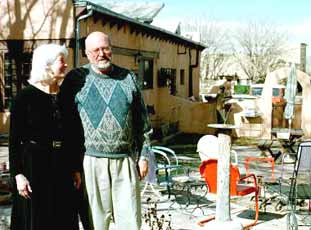 Elaine Marr and Eliot Moore in their courtyard.
"We need to take better care of the
Earth's environment." (Socorro, New
Mexico) Elaine Marr and Eliot Moore in their courtyard.
"We need to take better care of the
Earth's environment." (Socorro, New
Mexico) |
| Supported by the State, the University and
the Corporate Community Ineffective Monitoring Functions |
![]() Information flow restricted even within
the university
Information flow restricted even within
the university
People tend to move to New Mexico for its
natural blessings-the azure sky, dry air,
warm climate, boundless plains.
"We love nature out here, but because
there's so much land and so little population,
nuclear facilities have been cropping up
here ever since the Manhattan Project which
built the first A-bomb. We worry about high
levels of radiation. We don't feel safe even
in Socorro." Lawyer Elaine Marr (68)
looks at her husband, Elliott Moore (63),
a university professor.
Elliott and Elaine's enormous home near central
Socorro is built of New Mexican red clay
around a large courtyard. I was offered a
seat in the dining room. "It was 1972
when people here first directly experienced
the fear of radiation. That was when they
started firing depleted uranium shells at
the firing range affiliated with the New
Mexico Institute of Mining and Technology,"
said Elliot, a space physicist. Though a
professor at that university, he knew nothing
about its DU testing until the late 80's.
"Only the staff at the Energetic Materials
Research Test Center (EMRTC) are involved
in developing weapons. People in different
fields know nothing about it," he adds,
lamenting the high walls of secrecy at his
university.
![]() Real tanks as targets
Real tanks as targets
Elaine and Elliot smiled wryly when I talked
about my interview with Vice President Van
Romero (44).
"His definition of 'open-air firing,'
that the DU is only in the air while it flies
from the gun to the catching box, is quite
unique, isn't it? But it has nothing to do
with reality, nor does his statement that
they were using a catch box from the beginning,"
Elaine insisted.
Elaine and Elliot belong to a grassroots
organization called Save Our Mountain. They
have obtained information from former employees
at the firing range and from official documents
accessed under the Freedom of Information
Act. "There was no shielding at all,
at least for the firing done in 1970's. It
was literally open-air. And real M60 tanks
were used as targets. Not only that, they
used the firing range closest to town."
Continuing Elaine's train of thought, Elliot
said, "The main thing they wanted to
know from that early testing was the effect
of the speed of the DU penetrators on the
impact they impart. During that time, they
generated a lot of DU oxide particles. We
have no idea how much was inhaled, not just
by the people involved but by all of us living
around here."
Admitting that the range might have started
using a catch box for a shield in the 1980's,
Elaine and Elliot are nevertheless convinced
that plenty of smoke, undoubtedly filled
with DU particles, continued to rise into
the air despite the boxes.
![]() Foundation created for cover
Foundation created for cover
In 1991, around the time of the Gulf War,
companies manufacturing DU munitions contracted
with a university foundation, and test firing
increased.
"The university uses that private foundation
to hide the terms of its contract with those
companies. And companies use the university's
autonomy to avoid having to disclose the
environmental impact of DU munitions firing.
The state government supports the whole deal.
There is absolutely no proper check on what
they are doing."
Elaine explained the relationships among
the state, the university, and the companies
in a logical, lawyerly manner. She pointed
out that the state is essentially a "nuclear
estate," that is, economically dependent
on the Los Alamos National Laboratory and
the many other nuclear-related organizations
that have been accumulating for decades.
The university has said that firing of DU
munitions stopped in 1993. "But they
are still allowed to store 58 tons of DU.
If they decide to use it, they can easily
make up for the lost time."
Elaine and Elliot's distrust of the university
seemed to speak for the silent residents
of Socorro.